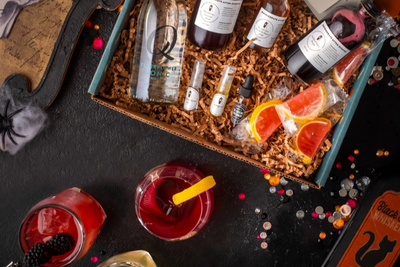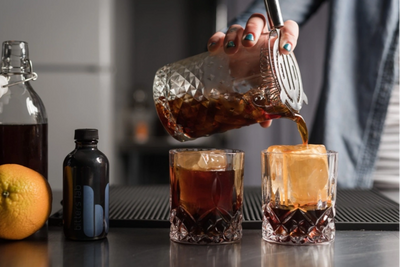How Much Is a Dash of Bitters?
Updated by Lindsay Mattison
If you’re looking to take your cocktail game to the next level for dinner parties or holiday gatherings , using bitters is the easiest way to go from amateur mixologist to professional bartender. You’ll see this phrase—_add a “dash of bitters”_—in cocktail recipes that call for the use of this interesting liquid, but what does that mean? Exactly how much is a dash of bitters? How do you measure it?
Cocktail bitters are tiny bottles of, well,_ bitter_ liquid used to add flavor to cocktails and are made by infusing spices and herbs into neutral grain spirits, like Everclear or vodka. A bottle of bitters can contain anywhere from 35 to 45 percent alcohol, but bitters are used in such small quantities that it typically contributes less than 1 percent alcohol-by-volume to a drink. The character of each bottle of cocktail bitters varies depending on the botanicals used, from citrus and cocoa to peach and rhubarb. The most famous bitters are Angostura with hints of cinnamon and clove, Regans’ No. 6 with its orange-forward flavor, and Peychaud’s , an integral component of a good Sazerac.

All bitters have one thing in common: they’re very intensely flavored, so they don’t taste great on their own. That’s the reason why an Old Fashioned calls for a full two ounces of whiskey but only three dashes of Angostura bitters! A little goes a long way toward balancing out the other components in a cocktail, creating an incredible depth of flavor.
How Much is a Dash of Bitters?
A dash of bitters is a guideline that allows you to add a standardized amount of bitters without requiring the use of measuring spoons. Add bitters to your recipe by simply tipping the bottle upside down and giving it a firm shake. Most bitters bottles have a cap with a small hole in the middle designed to release the same amount of liquid with every shake.
But does that really answer the question, “How much is a dash of bitters?”
Not exactly.
It turns out there’s a bit of confusion among bartenders as well. Some will tell you a dash is between 1/8 teaspoon and 1/4 teaspoon, which sounds like a big disparity! Reyka Vodka’s U.S. brand ambassador, Trevor Schneider, told the Kitchn that a dash absolutely varies from one bartender to another. The amount of force put behind the shaking of the bottle, or the angle of the bottle itself, can affect the exact quantity of liquid that’s released.
If you want to be very scientific about it, Schneider says the exact “dash” amount is just scant of one milliliter or 1/5 teaspoon. You can measure a dash very precisely when you make cocktails by using a dropper as a measuring tool (like the ones you would find in aromatherapy bottles). Instead of shaking the bottle, fill a clean dropper with bitters and release exactly 10 drops into the drink.

Do you need to get this precise to make great craft cocktails at home? Not necessarily. If you mix your cocktail and find that it needs a little bitters boost, give the bottle another shake into the finished drink. That said, it’s significantly easier to add extra bitters than it is to balance out a drink if you accidentally go too far. In that case, you would need to add a little more of everything else in the drink—liquors, simple syrup, citrus juice, etc.—to make it right. If you’re worried about balance, start small and know that you can always add extra bitters.
How to Use Bitters
The very best way to start experimenting with bitters is to pick up a few different flavors and give them a taste test. They may taste odd on their own, so try adding a few dashes of bitters to an ice cube (or sugar cube) before pouring in your favorite bourbon or whiskey. As you sip, consider how the flavor and aroma of the whiskey has changed with the new addition.

What you’ll find is that bitters mix well with almost any liquor. They’re able to add flavor to neutral-tasting vodka, bring out the citrus and pine in gin, balance out rum’s sugary finish, and enhance whiskey’s barrel-aged goodness. You’ll also find a whole world of non-alcoholic pairings, like bits and bubs . A dash or two of bitters in a glass of soda water is a delightful way to enjoy a complex drink while staying sober for the evening.
So what are you waiting for? Pick up a few bottles and start experimenting. You may just find that these tiny bottles are the key to taking your cocktails to the next level.







